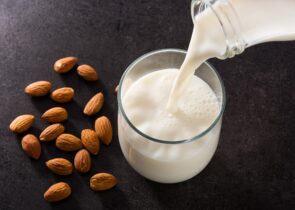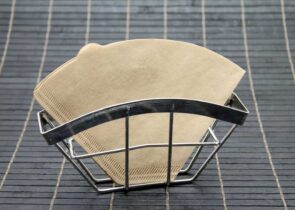If you’re serious about brewing coffee at home, there’s a good chance you’ve heard of the Baratza Encore. This burr grinder is highly sought-after by both home baristas and small café owners despite it being out on the market for more than a decade.
Baratza calls it the ultimate entry-level multipurpose grinder, capable of everything from fine espresso grinds to coarse cold brew particles. I’ve been using mine for about ten years, and I find it excellent for pour overs, auto drip machines, and french press, rivaling even newer grinders that are many times more expensive.
So what about other methods? And which settings are the best to use? Don’t worry, we cover all that and more in our comprehensive grind setting guide for the Baratza Encore!
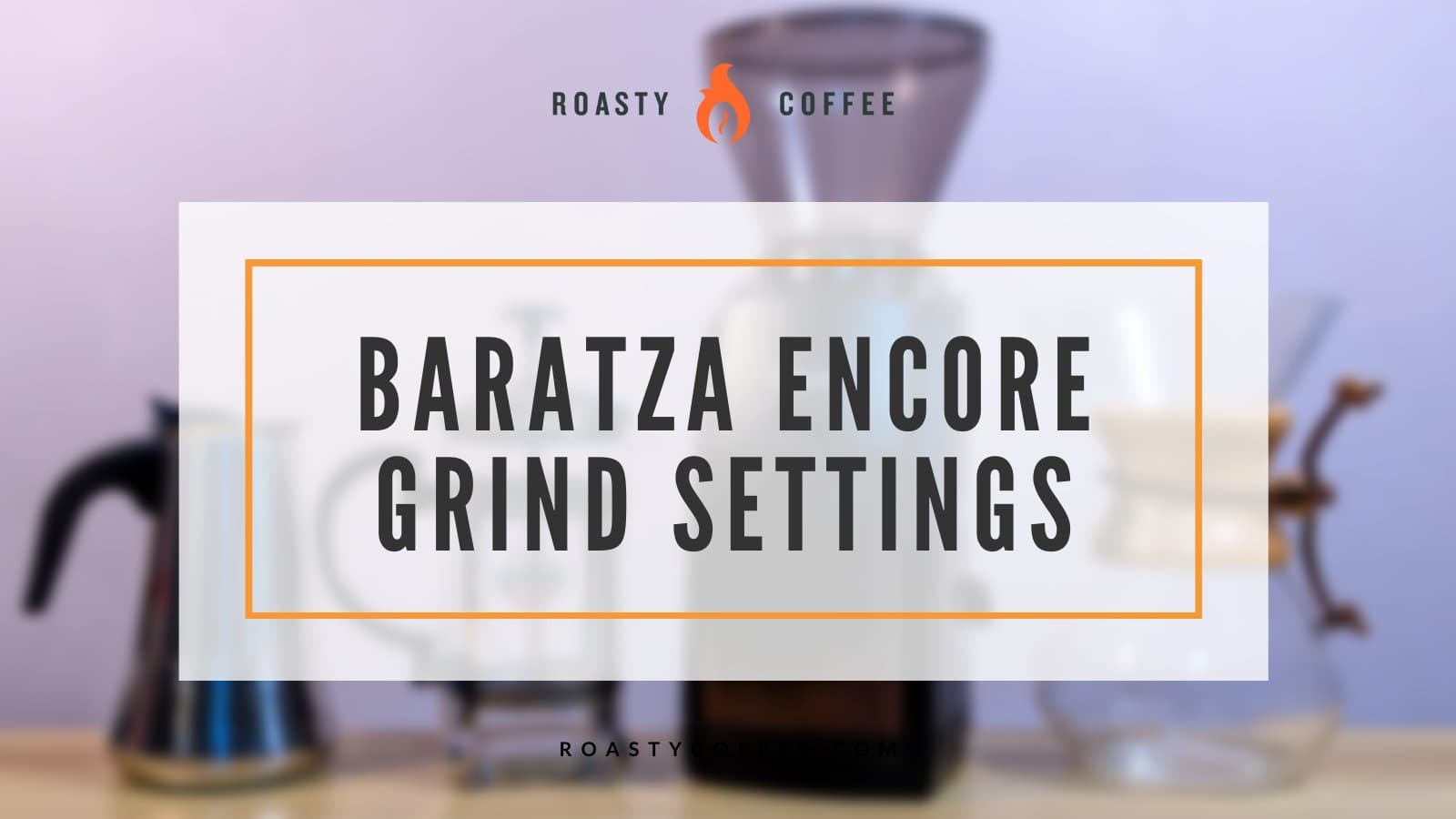
Understanding the Encore’s 40 Grind Settings
The Baratza Encore has 40 different grind settings that covers a wide range of brewing methods. But similar to other grinders, these numerical values serve only as markers that are specific to your unit.
Even two Baratza Encores might be calibrated a little differently from the other. So when we talk grind sizes, a more tangible measurement would be the size of the grind particle, measured in microns, or 1/1000 of a millimeter — also represented as ‘um’.
To measure coffee grounds in microns, you need a set of sieves such as the Kruve Sifter. We spent many hours using six differently-sized sieves to sift thru the Encore’s entire grind range. What we learned helped us understand both this grinder’s strengths and limitations.
You can skip ahead to the second half of this article for actual grind setting recommendations for the Encore, including a visual guide and some frequently asked questions. But if you’re interested in how we got there, read on!
How Fine Should You Grind Coffee
We took the brew guide that came with our Kruve Sifter and built on it with our own testing. Here’s a list of methods and their typical particle size range:
| Brew Method | Micron Range | Grinds Description |
|---|---|---|
| Turkish | 100-200 um | Powdery-fine |
| Espresso | 200-600 um | Fine to Medium-fine |
| Moka Pot | 300-600 um | Medium-fine |
| Aeropress | 400-1000 um | Medium-fine to Medium-coarse |
| Pour over | 500-900 um | Medium-fine to Medium-coarse |
| Syphon | 500-1200 um | Medium-fine to Medium-coarse |
| Auto Drip | 700-1200 um | Medium to Medium-coarse |
| Cupping | 800-1000 um | Medium-coarse |
| French Press | 800-1400um | Medium-coarse to Coarse |
| Cold Brew | 1000-1600 um | Coarse to Extra Coarse |
Here’s a short comparison of our grind descriptions to everyday items, to add context to the table above:
- Powdery-fine: cocoa powder, powdered sugar
- Fine: table salt, caster sugar
- Medium-fine: granulated sugar
- Medium: cornmeal, beach sand
- Medium-coarse: sea salt
- Coarse: pretzel salt
- Extra-coarse: crushed peppercorns
If you want a more detailed look into grind settings, check out this article here. For now, let’s dive right into the Encore’s grind performance across its 40 settings.
Baratza Encore Range in Microns
The Baratza Encore’s 40mm conical burr set is rated for grinds as small as 250 microns, and as large as 1200. This gives it the range needed from quick extraction methods that use fine grinds (like espresso), to slower brews that require bigger particles (like french press and cold brew).
At least on paper, that is! Good thing we have a set of sieves on hand so that we can put this to the test.
Keep in mind that the intention here isn’t to nitpick official spec sheets. The aim here is to build a fully-tested list of grind settings to give you the best possible brews for your desired brew method.
Finest and Coarsest Settings
The smallest particles on the finest setting (#1) passed through the 300-micron sieve, with virtually no grinds making it through the 200-micron one. No surprise here: The burrs work right as advertised on the fine end, allowing it to pull espresso duty.
Grind particles appear to be a little bit bigger on the coarsest setting (#40). We didn’t have a sieve larger than 1000 microns (equal to 1mm or 1/25th of an inch) to measure this precisely. But with particles of this size, a ruler comes in handy to estimate things.
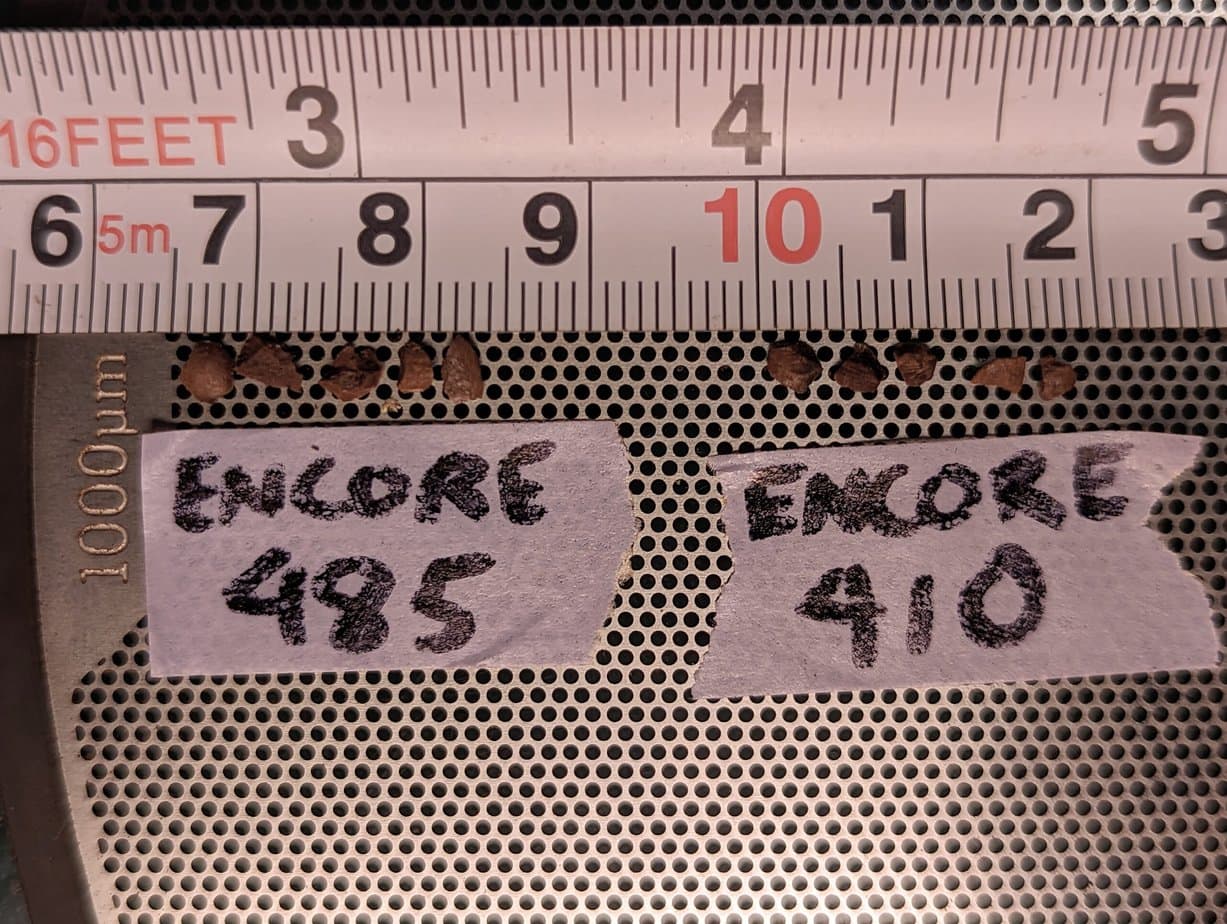
Each hole in the 1000-micron sieve is 1mm in diameter — so we can estimate these large particles to be at least 1.5 to 2x bigger
We borrowed another Encore (a newer model 410) just to be thorough, and the results are pretty much the same: At the coarsest setting, the grind particles are visibly above the rated 1200 microns. In our visual estimation, the Encore can do 1500 to 2000 microns, which is way bigger than you’ll ever need!
And Everything in Between
The Encore’s strengths lie in medium-fine to medium-coarse applications, which on our unit are settings #10 through #28. This is because of the grinder’s excellent particle size distribution within this range.

The Encore excels at brew methods ranging from moka pot to pour over drippers to french press!
Simply put, there’s much less variation in the coffee grinds for each of these middle settings, especially when compared to similarly-priced grinders. Less grind variance means brews that aren’t just better-tasting, but repeatable as well.
Testing The Encore’s Particle Size Distribution
The final piece of the puzzle before we can definitively match each grind setting to a particular brew method is to test them all. Once again, our Kruve sieves come in handy for our experiments so get ready for some grind geekery!
This is how we tested each of the Baratza Encore’s grind settings:

- Weigh 20 grams of whole bean coffee
- Grind the coffee to a specific setting
- Pour the ground coffee on top of our Kruve sifter’s finest sieve (200 microns)
- Shake the Kruve to sift the grinds through
- Weigh out the grinds that passed through the sieve, and the ones that got left behind
We repeated this process for the other five sieves we had (300um, 400um, 600um, 800um, and 1000um) before we moved to the next grind setting. After many hours of grinding and shaking, we have our results:

This bar chart shows the grind consistency of the Baratza Encore for a particular grind setting. We’ve skipped every four settings to keep it short, but you get the picture.

And here’s an actual picture that represents one of the grind settings (#28) in the chart above.
What Grind Setting to Use For Your Baratza Encore
Based on hours of grind sifting and countless brews, below is a comprehensive list of grind settings for the Baratza Encore:
| Brew Method | Grind Setting | Grinds Description |
|---|---|---|
| Espresso | 4-10 | Fine |
| Espresso (pressurized portafilters) | 8-12 | Fine to Medium-fine |
| Moka Pot | 10-12 | Medium-fine |
| Aeropress (1-2 minute brews) | 12-14 | Medium-fine |
| Pourover Dripper — Large Aperture (Hario V60, Origami, Cafec Flower) | 14-16 | Medium-fine to Medium |
| Siphon Brewer | 14-22 | Medium-fine to Medium-coarse |
| Pourover Dripper — Small Aperture (Melitta, Kalita Wave, Beehouse) | 18-20 | Medium |
| Auto-drip Brewer | 16-22 | Medium to Medium-coarse |
| Chemex | 18-22 | Medium to Medium-coarse |
| Aeropress (3+ minute brews) | 20-22 | Medium-coarse |
| Clever Coffee Dripper | 20-22 | Medium-coarse |
| Cupping | 20-22 | Medium-coarse |
| French Press | 20-28 | Medium-coarse to Coarse |
| Cold Brew | 24-30 | Coarse to Extra Coarse |
| Cowboy Coffee | 30+ | Extra Coarse |
These settings are by no means 100% accurate to your grinder, but they will give you a decent starting point to work with. There are a couple of reasons why that is, which we’ll talk about in the next section.
As always, if your brews are too thin and sour (underextracted), move a couple of notches finer. And if they’re bitter and hollow, grind coarser.
The Encore’s Grind Settings In Photos
The biggest reason two Baratza Encores might grind slightly differently from each other is due to an adjustable “zero point”. In simple terms, there’s some wiggle room with how fine (or how coarse) the finest setting is, which shifts the entire grind range if you choose to modify it.
We won’t get into that but if you’re interested, Baratza has an illustrated recalibration guide that will get you sorted.
Our idea of a visual guide is to show you photos of our Encore’s grinds to see how similar (or far off) your machine is to the one we have. Check these out, sorted from finest to coarsest:






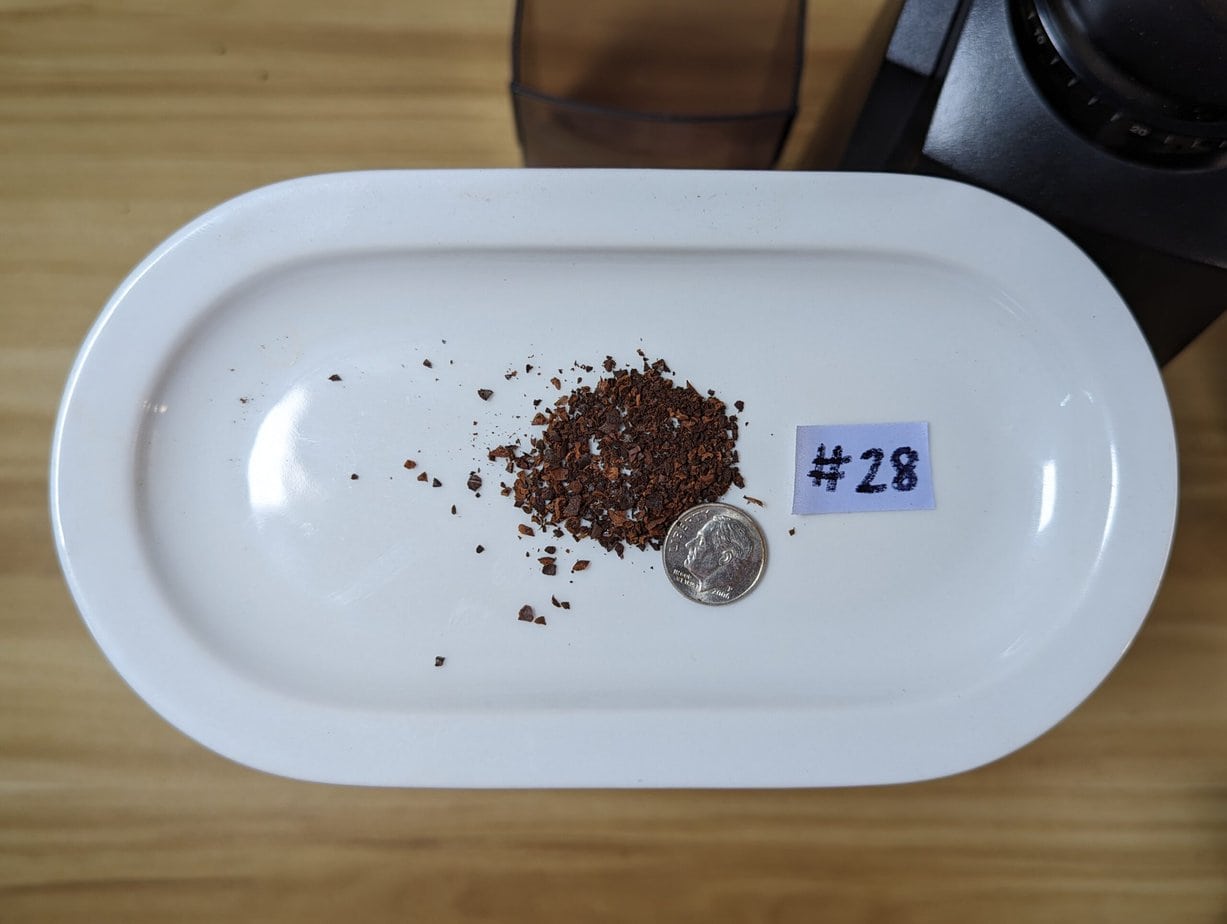



Frequently Asked Questions
Can the Encore Do Turkish Coffee?
Turkish Coffee requires super-fine particles of 100-200um, and the Encore’s burr just does not grind fine enough. You can try going as fine as your grinder allows, but expect more noticeable grit than normal for this method.
Can the Encore Do Espresso?
Yes! However, it’s not the most capable performer for this brew method for two reasons:
First, the steps between grind settings are too large to allow you to properly dial in your espresso shots. Moving from #8 to #9 on our unit meant a brew time difference of more than 5 seconds for the same target volume of espresso.
Second, the Encore grinds painfully slow at settings below #10. In our sifting experiments, it took upwards of 30 minutes (1 minute on, 1 minute off to protect the motor and gearbox) to grind 20 grams of a medium-roast coffee at the finest setting. Using a darker roast moved things along quicker, but 15 minutes is still quite the wait.
So while the Encore can technically grind fine enough for espresso, we don’t recommend it as a dedicated grinder for this purpose.
My Encore Grinds Finer/Coarser Than Yours. Can I Still Use This Guide?
Don’t worry, your zero point might just be different! Say if your Chemex brews great at #24 instead of the #22 we recommended, try shifting our recommendations by +2 across the board to compensate.
Final Thoughts
The Baratza Encore is a capable performer for most slow-brew methods, and it can do espresso too in a pinch. Our guide gives you a great starting point for a wide variety of brew methods, but always remember to follow your palate!
Happy Brewing!





